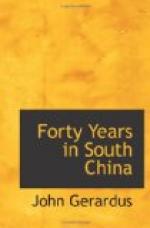On Dec. 23, 1857, he wrote to Dr. Isaac Ferris, who, since the separation from the A.B.C.F.M. at the last Synod, had become the Corresponding Secretary for the Board of Foreign Missions of tile Reformed Church.
“So far as we can judge from the report of the proceedings of General Synod as given in the Christian Intelligencer, one of the most important considerations, perhaps altogether the most important mentioned, why the church gathered by us here should not be an integral part of the Church in America, was entirely overlooked. That consideration relates to the unity of Christ’s Church. Will our Church require of us, will she desire that those here who are altogether one,-one in doctrine, one in their views of church order, and one in mutual love,-be violently separated into two denominations? We cannot believe it. Suppose the case of two churches originally distinct, by coming into contact and becoming better acquainted with each other, they find that they hold to the same doctrinal standards, and they explain them in the same manner; they have the same form of church government and their officers are chosen and set apart in the same way; they have the same order of worship and of administering the sacraments; all their customs, civil, social, and religious, are precisely alike, and they love each other dearly; should not such churches unite and form but one denomination? Yet such a supposition does not and cannot represent the circumstances of the churches gathered by us and by our Scotch brethren of the English Presbyterian Church. Our churches originally were one, and still are one, and the question is not whether those churches shall be united, but shall they be separated? Possibly the question will be asked, why were these churches allowed originally to become one? We answer, God made them so, and that without any plan or forethought on our part, and now we thank Him for His blessing that He has made them one, and that He has blessed them because they are one.
“Our position is a somewhat painful one. We desire to give offense to no one, and we do not wish to appear before the Church as disputants. We have no controversy with any one. We have neither the time nor inclination for controversy. We are ‘doing a great work,’ and cannot ‘come down.’ Yet our duty to these churches here and to the Church at home and to our Master demands of us imperatively that we state fully and frankly our views. We have the utmost confidence in our church. We have proved this by endeavoring to get our views fully known.”
The subject did not come up again for discussion before the General Synod until 1863.
Meanwhile the churches grew and multiplied. The Amoy church, which in 1856 had been organized by “the setting apart of elders and deacons,” was separated into two organizations in 1860, “preparatory to the calling of pastors.”
Two men were chosen by the churches in 1861. In 1862 an organization was formed called the “Tai-hoey,” or “Great Elders’ Meeting,” consisting of the missionaries of both the English Presbyterian and Reformed Churches and the delegated elders from all the organized congregations under their united oversight. The two men chosen as pastors were examined, ordained, and installed by this body.




